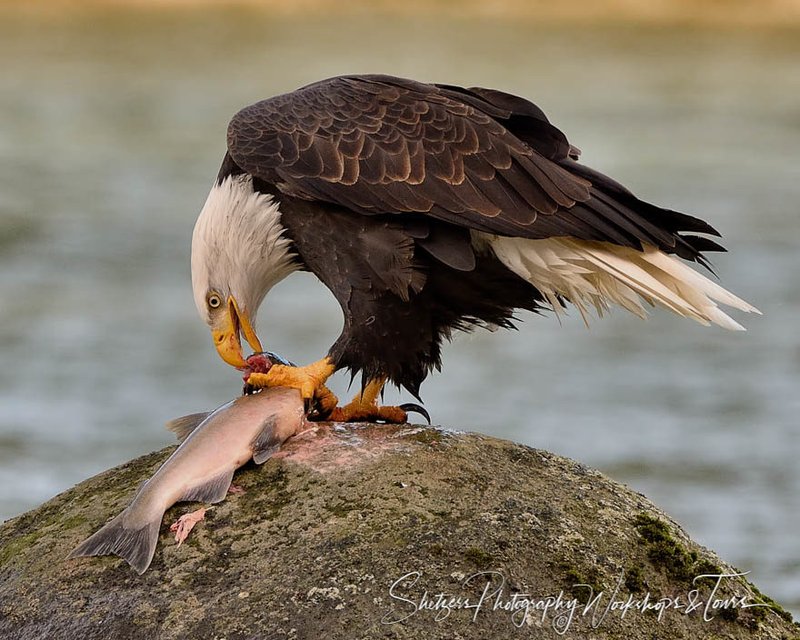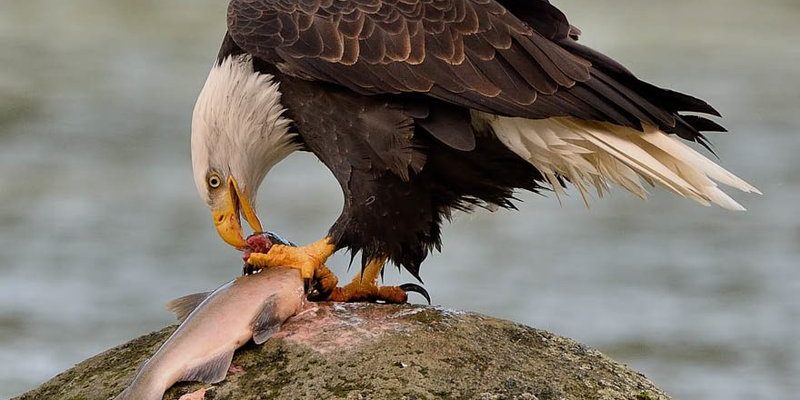
Bald eagles are not just picky eaters; they’re opportunistic hunters, which means they will eat whatever is available. This versatility is key to their survival. From fish to small mammals, their menu varies greatly depending on their location and the season. Think of them as nature’s ultimate foodies, always on the lookout for a delicious meal. Let’s explore the details of what they eat and how they catch their food.
Diet of the Bald Eagle
Bald eagles primarily feast on fish, specifically species like salmon, trout, and catfish. These aquatic delights make up a significant portion of their diet, especially for those living near lakes and rivers. Their excellent eyesight—capable of spotting fish from hundreds of feet in the air—gives them a distinct advantage. They can spot a ripple on the water’s surface and swoop down to catch their meal.
Besides fish, bald eagles also eat birds, small mammals, and carrion. You might be surprised to learn that they won’t shy away from stealing from other birds of prey like ospreys. It’s not just about catching fish; it’s about being resourceful. The opportunistic nature of these eagles means they’ll eat what’s most accessible, allowing them to adapt to different environments.
In areas where food is scarce, they will consume land animals like rabbits or squirrels. The variety in their diet helps them thrive in various habitats, from coastal regions to forests, showcasing their adaptability as predators. They’re a bit like the ultimate buffet diners, sampling different dishes based on what’s on the menu!
How Bald Eagles Hunt
The hunting techniques of bald eagles are quite impressive. Picture this: you’re a bald eagle, soaring effortlessly on thermal currents. You spot a shimmering fish below. What happens next? The eagle will dive at incredible speeds, using its sharp talons to snatch up dinner. This hunting strategy is often called “stooping,” and it requires precision and speed.
Bald eagles tend to hunt alone or in pairs, but their social nature sometimes brings them together during feeding frenzies. If a group of them spots a school of fish, you can bet they’re diving in for a feast. Their hunting skills are refined through practice and experience. Young eagles will often learn from older, more seasoned hunters, watching and mimicking their techniques. This is a perfect example of how knowledge and instinct blend beautifully in nature.
One fascinating aspect of their hunting is their ability to steal food. Eagles have been known to rob ospreys of their catch, showcasing their brazen side. That’s right! If an eagle sees an osprey with a fish, it might harass the smaller bird until it drops the meal. It’s a risky move, but for a hungry eagle, it’s often worth it.
Foraging Techniques
Aside from actively hunting, bald eagles often resort to foraging, which is another smart way to find food. They will frequently search for already-dead animals or leftovers from a predator’s meal. This behavior helps them conserve energy, as hunting can be demanding.
You might wonder how they know where to find these meals. Eagles rely on their keen eyesight and strong sense of observation. They can spot scavenging opportunities not only from the air but also from high perches. If they notice a flock of crows or vultures, it’s a good bet there’s something worth investigating beneath them!
Another technique involves standing still near the water’s edge and waiting for fish to come close. This strategy is called “still hunting.” Instead of swooping through the air, the eagle patiently watches for the right moment to strike. It’s like waiting for the perfect moment to catch a wave while surfing—timing is everything!
Seasonal Variations in Diet
Bald eagles’ diets can change with the seasons, which is an important factor in their survival. During winter, when lakes freeze over, they may have a harder time catching fish. In these situations, they become even more versatile, focusing on carrion or small mammals.
In spring and summer, when fish is abundant, they tend to rely heavily on aquatic prey. This is the time of year you’ll see them gliding above rivers and lakes, scanning the waters for their next meal. The shift in diet doesn’t just reflect environmental changes but also impacts their reproductive success. Healthy eagles are more likely to be successful parents, ensuring the next generation continues the cycle.
This change in diet can also influence where they choose to nest. Eagles may migrate or relocate based on food availability, demonstrating their adaptability to changing ecosystems. You could say their diet is like a compass, guiding them to the best habitats for survival.
Challenges in the Bald Eagle’s Diet
While bald eagles are skilled hunters and foragers, they do face challenges when it comes to their diet. One significant issue is pollution in the water. Chemicals like mercury can accumulate in fish, making them hazardous for the eagles that consume them. This pollution has led to health issues in many eagle populations, impacting their hunting success and reproductive health.
Another challenge is habitat destruction. As people develop land for agriculture or urban areas, bald eagles lose critical nesting and hunting grounds. This not only affects their food sources but also their safety from human activity. Maintaining healthy ecosystems is essential for the well-being of bald eagles and other wildlife.
Climate change also plays a significant role. Shifts in temperature and weather patterns can affect fish populations and the availability of prey. As their environment changes, bald eagles must adapt, and those that can’t might struggle to find enough food.
The diet of the bald eagle is a remarkable aspect of its life. From expertly hunting fish to scavenging for carrion, these birds demonstrate incredible versatility and resourcefulness. Their unique hunting strategies and foraging techniques showcase their adaptability, enabling them to thrive in various habitats and circumstances.
Despite the challenges they face, bald eagles continue to be a symbol of strength and resilience. By understanding what they eat and how they hunt, we can appreciate these magnificent birds even more. So next time you see a bald eagle soaring through the sky or perched on a tree, remember all the incredible skills it employs to find its next meal. It’s not just about the hunt; it’s about survival in an ever-changing world.

